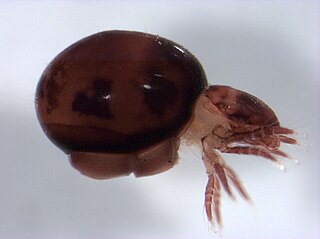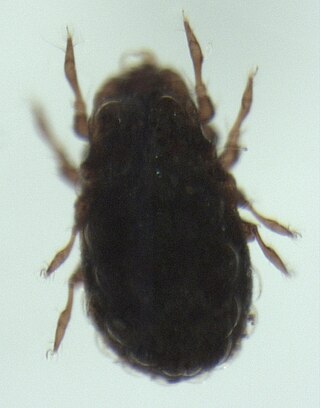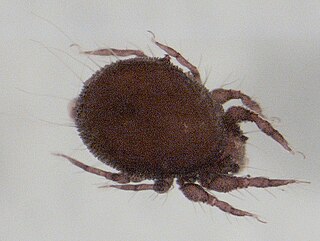
The Acaridae are a family of mites in order Sarcoptiformes.

Mesostigmata is an order of mites belonging to the Parasitiformes. They are by far the largest group of Parasitiformes, with over 8,000 species in 130 families. Mesostigmata includes parasitic as well as free-living and predatory forms. They can be recognized by the single pair of spiracles positioned laterally on the body.

Oribatida, also known as oribatid mites, moss mites or beetle mites, are an order of mites, in the "chewing Acariformes" clade Sarcoptiformes. They range in size from 0.2 to 1.4 millimetres. There are currently 12,000 species that have been identified, but researchers estimate that there may be anywhere from 60,000 to 120,000 total species. Oribatid mites are by far the most prevalent of all arthropods in forest soils, and are essential for breaking down organic detritus and distributing fungi.
Austrophthiracarus is a genus of mites in the family Steganacaridae.

Zerconidae is a family of mites in the order Mesostigmata.

Carabodidae is a family of oribatids in the order Oribatida. There are at least 20 genera and 300 described species in Carabodidae.

Hermanniellidae is a family of oribatids in the order Oribatida. There are about 9 genera and at least 50 described species in Hermanniellidae.
Brachychthoniidae is a family of oribatids in the order Oribatida. There are about 11 genera and at least 150 described species in Brachychthoniidae.
Lohmanniidae is a family of oribatids in the order Oribatida. There are at least 20 genera and 180 described species in Lohmanniidae.

Galumnidae is a family of mites and ticks in the order Sarcoptiformes. There are at least 30 genera and 410 described species in Galumnidae.
Scheloribatidae is a family of mites and ticks in the order Sarcoptiformes. There are at least 20 genera and 320 described species in Scheloribatidae.
Mochlozetidae is a family of mites and ticks in the order Sarcoptiformes. There are about 12 genera and at least 50 described species in Mochlozetidae.

Enarthronota is a suborder of mites in the order Oribatida. There are about 14 families and more than 450 described species in Enarthronota.

Oripodoidea is a superfamily of oribatids in the order Oribatida. There are about 19 families and at least 1,300 described species in Oripodoidea.

Galumna is a genus of mites in the family Galumnidae.
Oribellidae is a family of mites belonging to the order Sarcoptiformes.
Oppiidae is a family of mites belonging to the order Sarcoptiformes.
Chamobatidae is a family of mites belonging to the order Sarcoptiformes.
Humerobatidae is a family of mites belonging to the order Sarcoptiformes.
Compactozetidae is a family of mites belonging to the order Oribatida.












